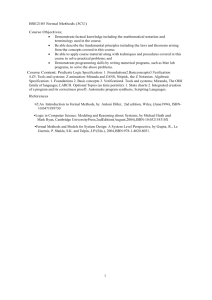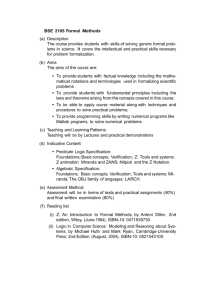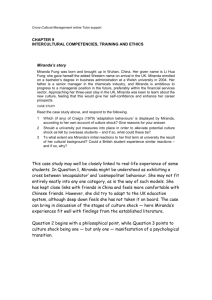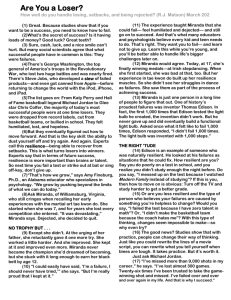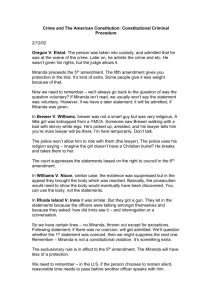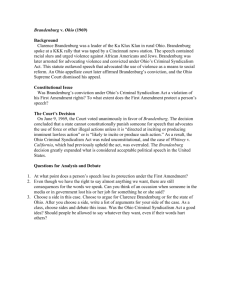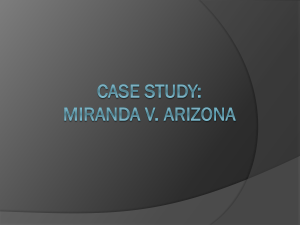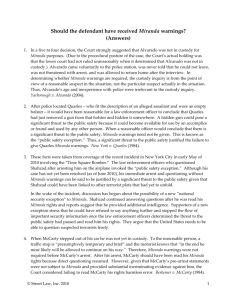DBQ practice
advertisement
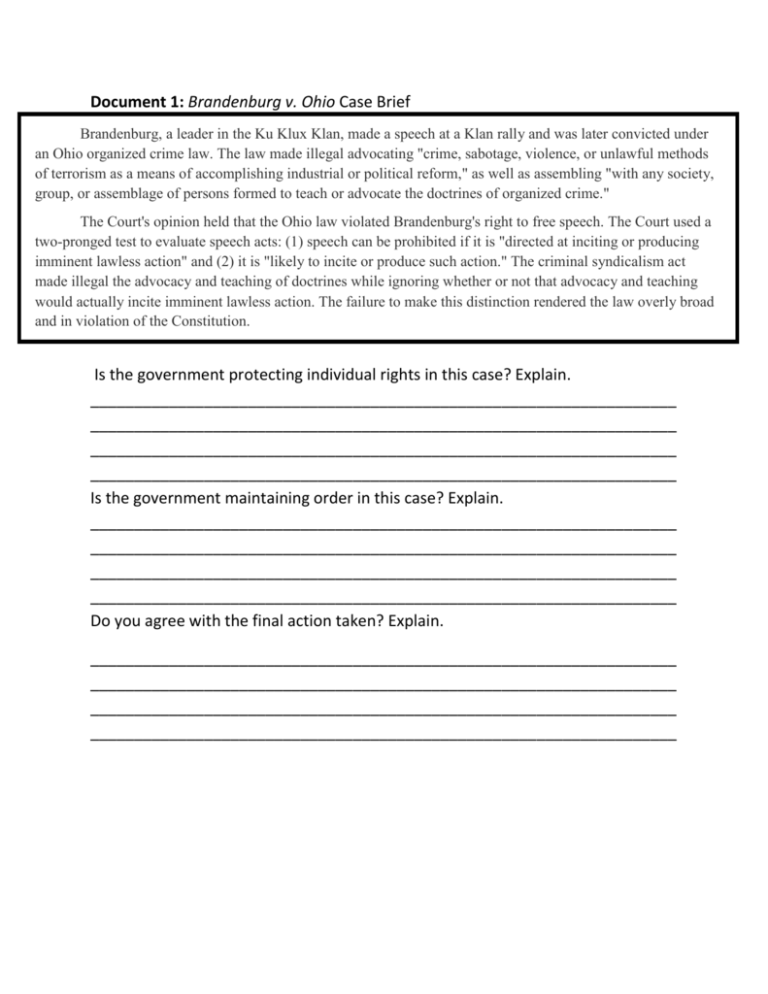
Document 1: Brandenburg v. Ohio Case Brief Brandenburg, a leader in the Ku Klux Klan, made a speech at a Klan rally and was later convicted under an Ohio organized crime law. The law made illegal advocating "crime, sabotage, violence, or unlawful methods of terrorism as a means of accomplishing industrial or political reform," as well as assembling "with any society, group, or assemblage of persons formed to teach or advocate the doctrines of organized crime." The Court's opinion held that the Ohio law violated Brandenburg's right to free speech. The Court used a two-pronged test to evaluate speech acts: (1) speech can be prohibited if it is "directed at inciting or producing imminent lawless action" and (2) it is "likely to incite or produce such action." The criminal syndicalism act made illegal the advocacy and teaching of doctrines while ignoring whether or not that advocacy and teaching would actually incite imminent lawless action. The failure to make this distinction rendered the law overly broad and in violation of the Constitution. Is the government protecting individual rights in this case? Explain. ___________________________________________________________________ ___________________________________________________________________ ___________________________________________________________________ ___________________________________________________________________ Is the government maintaining order in this case? Explain. ___________________________________________________________________ ___________________________________________________________________ ___________________________________________________________________ ___________________________________________________________________ Do you agree with the final action taken? Explain. ___________________________________________________________________ ___________________________________________________________________ ___________________________________________________________________ ___________________________________________________________________ Document 2: Article from Huffington Post: “Wiretapping Laws May Change to Include Internet Communication” 5/8/13 The FBI currently is authorized to access phone correspondence by the Communications Assistance for Law Enforcement Act, which requires phone companies to allow the government (with a court order) to directly intercept any communication. Some have suggested that this means that there is a database of recordings of all phone calls being stored by the government. Tech companies, on the other hand, are not required to give the government direct access to communications. Currently, authorities must ask companies like Google and Facebook for access to conversations. If there is a court order issued to the company within 180 days of the correspondence, emails can be found and read. If the 180 day mark has passed, the government is out of luck. Is the government protecting individual rights in this case? Explain. ___________________________________________________________________ ___________________________________________________________________ ___________________________________________________________________ ___________________________________________________________________ Is the government maintaining order in this case? Explain. ___________________________________________________________________ ___________________________________________________________________ ___________________________________________________________________ ___________________________________________________________________ Do you agree with the final action taken? Explain. ___________________________________________________________________ ___________________________________________________________________ ___________________________________________________________________ ___________________________________________________________________ Document 3: New York Times Article: “President Eisenhower Sends Troops to Little Rock” 9/24/57 President Eisenhower sent Federal troops to Little Rock, Ark., today to open the way for the admission of nine Negro pupils to Central High School. Earlier, the President federalized the Arkansas National Guard and authorized calling the Guard and regular Federal forces to remove obstructions to justice in Little Rock school integration. His history-making action was based on a formal finding that his "cease and desist" proclamation, issued last night, had not been obeyed. Mobs of pro-segregationists still gathered in the vicinity of Central High School this morning. Tonight, from the White House, President Eisenhower told the nation in a speech for radio and television that he had acted to prevent "mob rule" and "anarchy." Is the government protecting individual rights in this case? Explain. ___________________________________________________________________ ___________________________________________________________________ ___________________________________________________________________ Is the government maintaining order in this case? Explain. ___________________________________________________________________ ___________________________________________________________________ ___________________________________________________________________ Do you agree with the final action taken? Explain. ___________________________________________________________________ ___________________________________________________________________ ___________________________________________________________________ Document 4: Facts in the case Miranda v. Arizona The victim stood up and looked at each of the people in the police lineup. She turned to the officers and identified Ernesto Miranda as the man who had kidnapped and raped her. The Mexican immigrant was arrested and, after being questioned for two hours, Miranda confessed to the crimes in writing. He also acknowledged that he was aware of his right not to incriminate himself. His conviction, however, was overturned by the Supreme Court in this landmark case, Miranda v. Arizona (1966), as the police had not directly informed Miranda of the rights protected by the Fifth and Sixth Amendments. Is the government protecting individual rights in this case? Explain. ___________________________________________________________________ ___________________________________________________________________ ___________________________________________________________________ Is the government maintaining order in this case? Explain. ___________________________________________________________________ ___________________________________________________________________ ___________________________________________________________________ Do you agree with the final action taken? Explain. ___________________________________________________________________ ___________________________________________________________________ ___________________________________________________________________ Question: has the United States been more concerned with maintaining law and order or protecting the individual rights of US citizens? Step 1: Read and annotate the documents Step 2: Answer the questions below the documents Step 3: Create a thesis to answer the question. ___________________________________________________________________ ___________________________________________________________________ Step 4: Explain how at least three of the documents prove your thesis. a) Document #: and explanation… _____________________________________________________________ _____________________________________________________________ _____________________________________________________________ _____________________________________________________________ b) Document #: and explanation… _____________________________________________________________ _____________________________________________________________ _____________________________________________________________ _____________________________________________________________ c) Document #: and explanation… _____________________________________________________________ _____________________________________________________________ _____________________________________________________________ _____________________________________________________________ Step 5: Write an intro paragraph…
